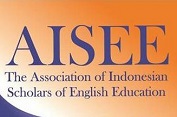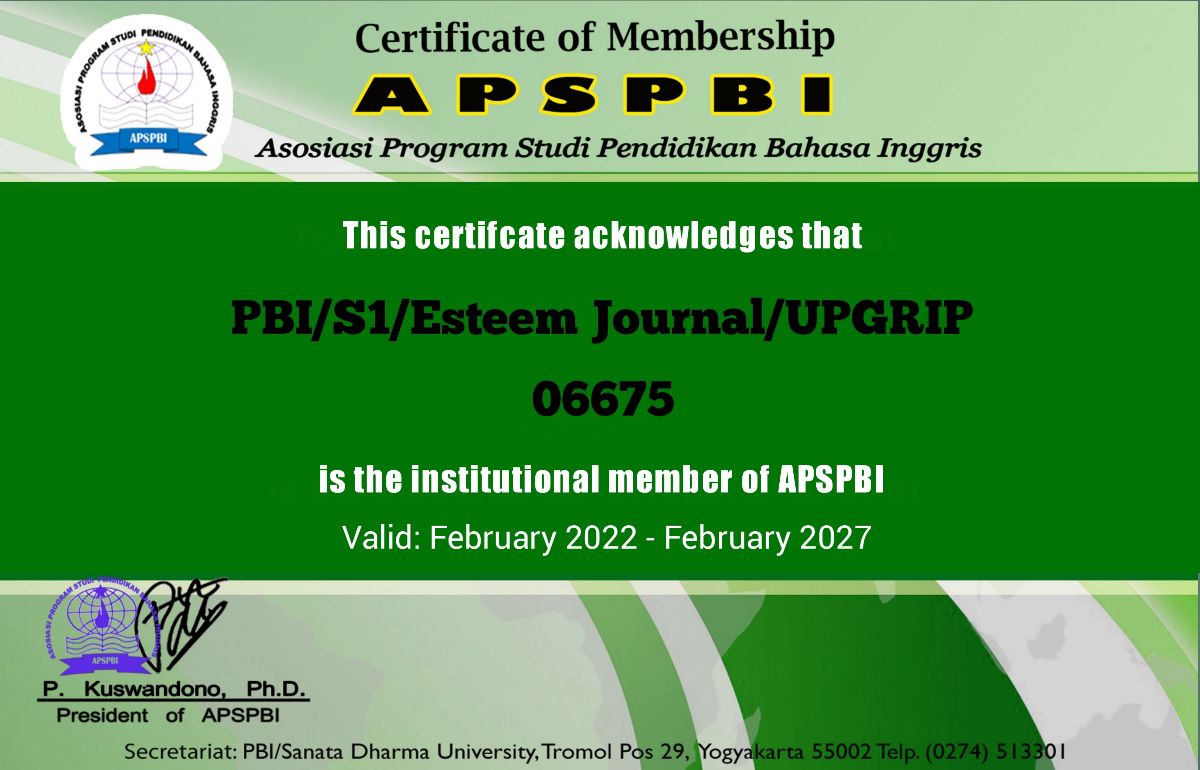Visual Scaffolding and Intensive Reading Strategies Based on Gender
DOI:
https://doi.org/10.31851/esteem.v4i1.5130Keywords:
Reading, Scaffolding, Intensive Reading, Strategy.Abstract
The objectives of this study are to find out whether or not; 1) there is a significant increase in students’ reading comprehension achievement based on after they are taught by using visual scaffolding strategy and intensive reading strategy and those who are not. 2) there is a significant contribution of visual scaffolding strategy and intensive reading strategy towards reading comprehension achievement of the high, average, and low achievers? This reserach used factorial experimental designs. These designs are essentially modifications of either the posttest-only control group or pretest-posttest control group designs. The sample was the students of PGRI University of Palembang. Two classes were chosen in which first class was experimental with male students was applied and the second was the second experiemnetal group trained by intensive reading strategy with the female students. The results showed that First, Visual scaffolding and Intensive Learning Strategy technique affected the students’ reading achievement of PGRI University. The result of t independent test was the mean of experiment group higher than mean of control group. It could be concluded, experiment group and control group were significantly difference and the visual scaffolding and Intensive Learning Strategy technique was effectively to use in improving students’ reading achievement.  The Second, there was an interaction effect of visual scaffolding and intensive learning strategy technique and students’ learning achievement toward the students’ reading achievement.
References
Depdiknas. (2006). Panduan Penyusunan Kurikulum Tingkat Satuan Pendidikan Jenjang Pendidikan Dasar dan Menengah. Jakarta: BSNP.
Diem, C. D. (1999). Intensive versus extensive reading. A paper presented at LKGI workshop for teachers of English of South Sumatera.
Dunn, R., Jeffrey, S. B., & Angela, K. (2002). Survey of research on learning styles. California Science Teachers Association. Vol. II., Issue 2.
Flemming, N. D. & Mills, C. (1992). Not another inventory, rather a catalist for relection. Professional and Organiational Development Network in Higher Education. Vol. 11.
Fraenkel, J. R. & Wallen, N. E. (2009). How to design and evaluate research in education. Boston, M.A: McGrawHill.
Graves, M. F., Watts, S., & Graves, B. B. (1994). Essentials of classroom teaching: Elementary reading. Boston: Allyn & Bacon.
Herrel, A. L., & Jordan, M. (2012). 50 strategies for teaching English language learners (4th ed.). Columbus: Pearson. retrieved from: http://missjenburns.blogspot.com/2011/10/visual-scaffolding-as-strategy-for.html
Hoover, W. A., & Gough, P. B. (1990). The simple view of reading. Reading and Writing: An Interdisciplinary Journal, 2(2), 127 - 160.
Jaya, A. 2017. Sentence Patterns of Narrative Text in English Textbook in Indonesia. English Community Journal. 1 (2).
Jaya, A. Hermansyah, Mortini, A. 2018. The Effect of Crawford Series Teaching (CST) on the Students’ Writing Achievement. ESTEEM: Journal of English Study Program. 1(1).
Kintsch, W. (1988). The role of knowledge in discourse comprehension: A construction-integration model. Psychological Review, 95(2), 163-182.
McCloskey, M. L. (2005). Visual scaffolding to support ELL reading. Salt Lake City: Rocky Mountain Tesol.
McKenzie, Jamie, (1999). Scaffolding for Success. From Now On: The Educational Journal, Vol. 9, No. 4. Retrieved November 1, 2002, from http://www.fno.org/dec99/scaffold.html.
McMillan, J. H. & Schumacher, S. (2010). Research in education: Evidence-based inquiry. Boston: MA. Pearson.
Nation, I. S. P. (2009). Teaching ESL/ EFL reading and teaching. ESL and Applied Linguistics Professional Series. New York: Routledge.
Pearson, P. D., & Gallagher, M. C. (1983). The instruction of reading comprehension, Contemporary Educational Psychology. 8, 317-344.
Pearson, P. D., & Fielding, L. (1991). Comprehension instruction. In R. Barr, M. L., Kamil, P. Mosenthal, & P. D. Pearson (Eds.) Handbook of reading research (Vol. II, pp. 815-860). Mahwah, NJ: Erlbaum.
Pisa 2012 results: which country does best at reading, maths and science? The Guardian. Retrieved from http://www.theguardian.com/news/datablog/2013/dec/03/pisa-results-country-best-reading-maths-science
Postlehwaite, T. N. (2005). Educational research: Some basic concepts and terminology. Ross, K. N. (Ed.). Paris: UNESCO International Institute for Educational Planning.
Pressley, M. (2002b). Comprehension strategy instruction: A turn-of-the-century status report. In M. Pressley & C. C. Block (Eds.), Comprehension Instruction Research-based best practices (pp. 11-27). New York: Guilford.
Pusat Kurikulum. Kurikulum Bahasa Inggris SMP 2006. Jakarta: Depdiknas, 2006.
Raymond, E. (2000). Cognitive Characteristics. Learners with Mild Disabilities (pp. 169-201). Needham Heights, MA: Allyn & Bacon, A Pearson Education Company.
Rogoff, B. (1990). Appretinceship in thinking. New York: Oxford University Press.
Safadi, E. & Rababah, G. (2012). The effect of scaffolding instruction on reading comprehension skills. International Journal of Language Studies (IJLS), Vol. 6(2), 2012 (pp. 1-38)
Scanlon, D. M., Anderson, K. L., and Sweney, J. M. (2010). Early intervention for reading difficulties: The interactive strategy approach. New York: NY. The Guilford Press.
Seyler, D. U. (2004). The reading context. New York: Pearson Longman.
Shumway, J. F. 2011. Number sense routines. New York: Lucy West.
Vygotsky, L.S. (1978). Mind in society: The development of higher psychological processes. Cambridge, MA: HarvardUniversity Press.
Wood, D., Brunner, J. S., & Ross, G. (1976). The role of tutoring in problem solving. Journal of Child Psychology and Psychiatry, 17, 89-100.
Walqui, A. (2006). Scaffolding instruction for English language learners: A conceptual framework. The International Journal of Bilingual Education and Bilingualism. Vol. 9, No. 2, 2006.
Willis, J. (2006). Research-based strategies to ignite students’ learning: Insights from neurologist & classroom teacher. Association for supervisor and curriculum developer (ASCD).
Wilson, M. L. (2011). Students’ learning style preferences and teachers’ instructional strategies: Correlations between matched styles and academic achievement. Dissertion. Liberty University.
Downloads
Published
Issue
Section
License
Copyright Notice
Authors who publish with this journal agree to the following terms:
In order to assure the highest standards for published articles, a peer review policy is applied. In pursue of the compliance with academic standards, all parties involved in the publishing process (the authors, the editors and the editorial board and the reviewers) agree to meet the responsibilities stated below in accordance to the Journal publication ethics and malpractice statement.
Duties of Authors:
- The author(s) warrant that the submitted article is an original work, which has not been previously published, and that they have obtained an agreement from any co-author(s) prior to the manuscript’s submission;
- The author(s) should not submit articles describing essentially the same research to more than one journal;
- The authors(s) make certain that the manuscript meets the terms of the Manuscript Submission Guideline regarding appropriate academic citation and that no copyright infringement occurs;
- The authors(s) should inform the editors about any conflict of interests and report any errors they subsequently, discover in their manuscript.
Duties of Editors and the Editorial Board:
- The editors, together with the editorial board, are responsible for deciding upon the publication or rejection of the submitted manuscripts based only on their originality, significance, and relevance to the domains of the journal;
- The editors evaluate the manuscripts compliance with academic criteria, the domains of the journal and the guidelines;
- The editors must at all times respect the confidentiality of any information pertaining to the submitted manuscripts;
- The editors assign the review of each manuscript to two reviewers chosen according to their domains of expertise. The editors must take into account any conflict of interest reported by the authors and the reviewers.
- The editors must ensure that the comments and recommendations of the reviewers are sent to the author(s) in due time and that the manuscripts are returned to the editors, who take the final decision to publish them or not.
Authors are permitted and encouraged to post online a pre-publication manuscript (but not the Publisher final formatted PDF version of the Work) in institutional repositories or on their Websites prior to and during the submission process, as it can lead to productive exchanges, as well as earlier and greater citation of published work (see The Effect of Open Access). Any such posting made before acceptance and publication of the Work shall be updated upon publication to include a reference to the Publisher-assigned DOI (Digital Object Identifier) and a link to the online abstract for the final published Work in the Journal.





















